India – Kochi, 12-19 Ottobre 2008
 MPEDA (The Marine Products Export Development Authority – Ministry of Commerce & Industry, Government of India, vedi sito web www.mpeda.com), per cinque giorni ha inaugurato il workshop con il Green Certification di pesci ornamentali in Kochi (Cochin), Kerala, India e Heiko Bleher è stato invitato oltre che a partecipare anche a fare una presentazione sul Ghats Occidentale) …
MPEDA (The Marine Products Export Development Authority – Ministry of Commerce & Industry, Government of India, vedi sito web www.mpeda.com), per cinque giorni ha inaugurato il workshop con il Green Certification di pesci ornamentali in Kochi (Cochin), Kerala, India e Heiko Bleher è stato invitato oltre che a partecipare anche a fare una presentazione sul Ghats Occidentale) …
India – Kochi, 12-19 Ottobre, 2008
 Il workshop organizzato da MPEDA (vedi sito web www.mpeda.com) ha sostenuto il Green Certification dei selvatici catturati dagli indigeni e la cultura dei pesci ornamentali per per l’esportazione. I cinque giorni di programma si sono basati su quello che è chiamato “Rainbow Revolution of India“ MPEDA fornisce assistenza finanziaria per gli allevamenti di pesci ornamentali e per le Società di marketing, qualcosa di unico, un progetto pioniere in tutto il mondo. Qui di seguito il comunicato stampa:
Il workshop organizzato da MPEDA (vedi sito web www.mpeda.com) ha sostenuto il Green Certification dei selvatici catturati dagli indigeni e la cultura dei pesci ornamentali per per l’esportazione. I cinque giorni di programma si sono basati su quello che è chiamato “Rainbow Revolution of India“ MPEDA fornisce assistenza finanziaria per gli allevamenti di pesci ornamentali e per le Società di marketing, qualcosa di unico, un progetto pioniere in tutto il mondo. Qui di seguito il comunicato stampa:
(AL MOMENTO DISPONIBILE SONO IN LINGUA INGLESE)
INTERNATIONAL WORKSHOP ON GREEN CERTIFICATION OF ORNAMENTAL FISH FROM 14TH TO 18TH OCTOBER 2008, KOCHI, INDIA
Sri. G. Mohan Kumar, Chairman Marine Products Export Development Authority inaugurated a five day workshop on the Green Certification of Ornamental Fish. This workshop was organized by MPEDA in association with project PIABA, Brazil and UNCTAD for developing guidelines on production and trade on green certified ornamental fish. Preparation of guidelines for Green Certification is a pioneering attempt to introduce eco-friendliness and product quality for ornamental fishes in the domestic and international arena. The workshop dealt with the green certification or eco-labeling to increment a fair value of product along the chain of bio-commerce in close association with the environment and stakeholders and during the workshop was also discussed the issues related to geographic indication (GI) of endemic fish species and processes and procedures involved. Shri. Kuruvilla Thomas presided over the function. Presentations were offered by sri. B. Vishnu Bhat, Dr. Alex Ploeg, Secretary General of Ornamental Fish International (OFI), the Netherlands, Dr. E. G. Silas, Prof. Madhusoodhana Kurup, Dr. I. S. Bright Singh and others, as well as by Heiko Bleher.
In the inaugural session chairman MPEDA, G. Mohan Kumar highlighted the pioneering effort taken on the issue of Green Certification and Geographic Indication of ornamental fishes. The efforts taken by MPEDA in making the Indian ornamental fish sector up to International Standards by implementing the scheme of Rainbow Revolution, was highlighted by Director (Marketing) Kuruvilla Thomas. Dr. E. G. Silas highlighted the importance of marking the fishes exported by biomarkers and microchips. Prof. Kurup expressed concerns over the depletion of indigenous ornamental fish resources and urged for preparing proper guidelines. [Note from the editor: Depletion of ornamental indigenous fishes is almost impossible, only by destruction of their habitats and pollution of the aquatic environment and by excessive consumption of the people.] Dr. Alex Ploeg, Secretary General of Ornamental Fish International (OFI) appreciated the steps taken by MPEDA in organizing this workshop and extended OFI’s support to this attempt. Sri. Anil Kumar, Assistant Director welcomed the gathering and introduced to the process lead to this workshop and Prof. Labbish Chao, Project Piaba described the implementation of ‘Buy a fish save a Tree’ program implemented in Amazon, Brazil and suggested the slogan ‘Buy a fish and save a family’ as this sector has tremendous potential to generate large scale employment in India. [Note from the editor: The program ‘Buy a fish and save a tree’ was never implemented in Brazil, only suggested. But the fact that native people collect ornamental fishes and earn a living from it exists in Amazonia since the late 1950s (long before Labbish Chao came to Manaus in 1989). This has contributed to conserve the natural environment in those Amazon regions where ornamental fishes are collected, as the poor people do not need to look for another income like deforestation to sell the lumber or to plant additional crop. In addition: the so-called Project Piaba does not exist (anymore) and has never implemented anything. The only premise Labbish Chao rented once and named ‘Project Piaba’ in the Amazon village of Barcelos is closed for years now and never functioned during the few years it was open. See also below and Bleher’s Discus volume I.]
Chairman Sri. Mohan Kumar released the book published by MPEDA on Ornamental Fish Diseases authored by Prof. Bright Singh, CUSAT. A series of books related to ornamental fish sector are under preparation.
The workshop was attended by stakeholders from producer level to wholesalers, exporters, importers and the hobbyists, in addition experts from overseas also contributed to evolve guidelines on the collection of ornamental fish from wild and production from the captive breeding. Technical sessions on the key aspects of green certification, geographic indication, good management practices, Marketing and socio-economic and environment aspects were presented and discussed for formulating proper guidelines. A field trip to fish collection sites, ornamental fish breeding units and export unit were also fixed on the third day to introduce the delegates to the actual process involved in collection, conditioning, breeding and export of ornamental fishes from India.
The possible advantages of certification are the following:
– A certification programme can be developed for indigenous fishes and cultured exotic ornamental fish species
– Possibility of obtaining of Geographical Indication for Puntius denisonii, and a couple of other species such as Carinotetradon travancoricus, Etroplus canarensis etc. – those which are endemic to a particular geographic area.
– Development of a training programme to equip the collectors for responsible utilization of the fishery resource and also reduce the loss of fish due to poor fishing methods, storage, handling and packing techniques (fish welfare). This will not only ensure eco friendliness and fish welfare but will improve the quality of fish and ensure a socially responsible business.
– Eco-labeling/Green Certification of the exported fish in international market.
– All these actions will link up the fishers to the international market and promote Brand building of Indian Ornamental fish.
Editors note: Below some photos of this worldwide unique event promoting the ornamental fish industry and its hobby. The Rainbow Revolution of India is already and the Green Certification can be of great benefit for many poor (rural) people in India, for them to earn a living and have a better live. It is a fantastic governmental (MPEDA) approach to finance and support many Indian families and an excellent example for every third-world country, including Brazil, which can learn from it.
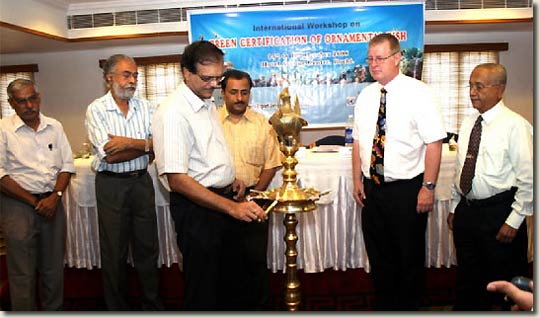
Il Presidente Sri G. Mohan Kumar ufficialmente “alleggerito” all’inaugurazione del Green Certification workshop

Sri. Anil Kumar (a sinistra) ha tenuto il discorso iniziale e il presidente Sri G. Mohan Kumar (a destra) ha evidenziato gli sforzi pionieristici

Il Prof. E. G. Silas, famoso ittiologo indiano conosciuto in tutto il mondo, ha parlato molto del Green Certification

Ogni ospite invitato ha ricevuto un dono, anche Heiko (a destra) …

... e il presidente del MPEDA ha distribuito un bel libro sulle malattie dei pesci ornamentali del Prof. Bright Singh
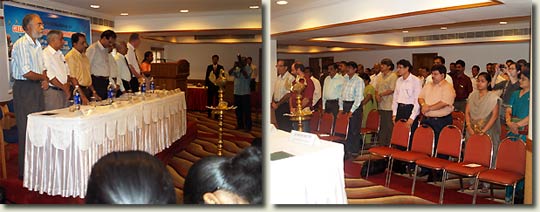
Per un minuto tutti si sono alzati per onorare Mr. Sharad R. Sane, pioniere delll’esportazione di pesci ornamentali provenienti dall’India (e il primo ad importare i primi pesci tropicali di Heiko alla fine degli anni 1960 e 1970). Sane è scomparso nella sua città di Mumbai il 14 maggio 2008. Durante i 5 giorni di workshop si sono tenute molte presentazioni – Heiko Bleher ha parlato dei pesci del Ghats occidentale – e qui di seguito solo alcune foto con alcuni commenti e suggerimenti presentati:
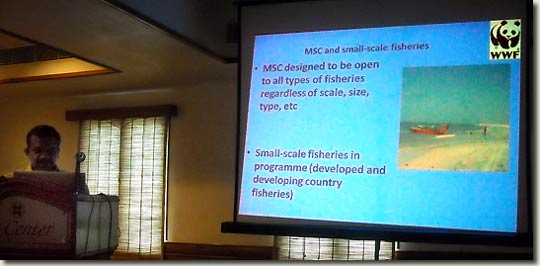
La presentazione, pratiche estistenti o in corso sui pesci di V. K. Dey o di Scott Dowd confrontate con MSC (Marine Steward Council) può essere solo in parte essere applicata al Green Certification, in quanto è molto differente nelle (e per) le creature marine dalle specie di acqua dolce. Le norme standard complete:
EFM (Ecosystem and Fisheries Management),
CFH (Collection, Fishing and Holding),
HHT (Handling, Husbandry and Transport), e
MAM (Mariculture and Aquaculture Management) possono essere applicate per argomento:
CEH (Collection practice, Eco-friendly Handling) THH (Transport, Holding, Husbandry)
APS (Acclimatisation, Packing, and Shipping).
Per allevamento e vivai ornamentali:
SBM (Standard Breeding Methods)
Da MSC i tre principi:
– La sostenibilità degli stock
– Impatto Ecosistema, e
– Una gestione efficace
potrebbero essere considerati (e in parte applicati).
Ma la maggior parte delle altre norme e/o certificazioni possono difficilmente essere di qualche utilità per la Green Certification. Naturalmente uno standard deve venire impostato e di conseguenza data una licenza agli esportatori.

Alex Ploeg, segretario generale di OFI, ha parlato delle certificazioni per i pesci ornamentali alla luce delle disposizioni per l’importazione e di altri requisiti dell’UE. Ma non sapeva che per esempio il bel Channa bleheri è un pesce ornamentale ben richiesto e venduto – come altre bellezze provenienti dall’India – in tutto il mondo.

Labbish Chao dall’Università di Manaus, in Brasile. Ha presentato (purtroppo) informazioni non aggiornate sull’Amazzonia, come “Compra un pesce – un albero sicuro” – cosa inesistente, come il Progetto Piaba, Centro di Conservazione acquatico a Barcelos, che è stato chiuso da un certo numero di anni, e dove si può rintracciare nessun numero dei pesci ornamentali esportati da Barcelos. Ha mostrato che nel 2002 sono stati esportati oltre 60 milioni di tetra cardinale (Paracheirodon axelrodi), mentre i numeri reali pubblicati dall’IBAMA sono stati di 10.371.392 nel 2002 e 13.700.564 nel 2003. Mai nella storia si era superata l’esportazione annuale di 20 milioni di P. axelrodi. Il grafico che mostrava la diversità genetica del tetra cardinale e la distribuzione era fuorviante e incompleto. Un’altra presentazione discutibile è stato il suo “Progetto Piaba abilita pescatori” un fatto sconosciuto, Labbish Chao è una volta all’anno (e non tutti gli anni) organizza un’escursione turistica nella zona Barcelos e parla ai piabeiros niente di più. Infatti la maggior parte delle persone del posto non ne ha mai sentito parlare. E, ultimo ma non ultimo per importanza il sito web (ora chiamato opefe.com / Piaba.html ) non è mai stato aggiornato dopo il 1999 (per circa 10 anni), tranne che per l’annuncio che messo della sua nuova “spedizione” del 24-27 GENNAIO 2010 da Manaus e le sue offerte per i viaggi turistici (e non “Progetti”). Ma questi non erano le sue uniche presentazioni “non rintracciabili”


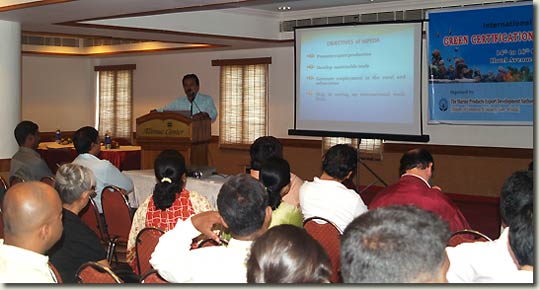
MPEDA ha iniziato nel 2008, ha introdurre l’assistenza per il design delle strutture per i pescei ornamentali per il Green Certification e gli obiettivi includono la promozione della produzione per l’esportazione, lo sviluppo del commercio e creazione di posti di lavoro
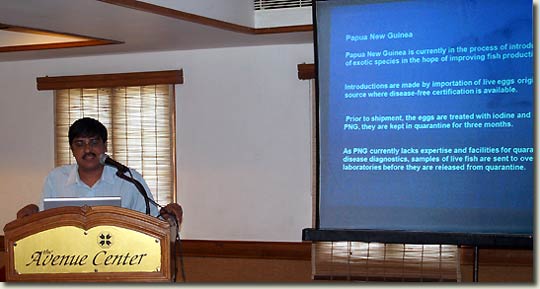
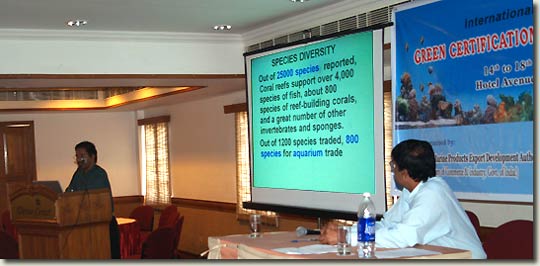
Ci sono stati molte eccellenti presentazioni, ma anche con un po di statistiche non aggiornate o solo superficialmente studiate come l’introduzione di specie esotiche in PNG processo già iniziato più di mezzo secolo fa in larga scala o le statistiche delle importazioni asiatiche di pesci ornamentali che non hanno mostrato i valori effettivi generati. Anche la presentazione delle diverse specie è stata di gran lunga superata, ci sono più di 30.000 specie di pesci e solo Heiko Bleher ne ha introdotte più di 3000 (vs. 800 specie indicate) nel commercio dell’acquario …



Ogni pomeriggio c’erano riunioni in tavole rotonde per discutere sui vari temi del Green Certification e ad un certo punto Labbish Chao ha mostrato le reti per la cattura tetra cardinale in Amazzonia, che aveva molto poco – o nulla – a che vedere con i metodi di pesca dei pesci in India … Anil Kumar, finita la riunione della tavola rotonda, raccoglieva gli appunti di tutti, e secondo i metodi concordati procedeva al Green Certification dei pesci ornamentali.

Dopo le sessioni di una bella festa-cena organizzata da MPEDA e Heiko ha avuto un intensa conversazione con il direttore Thomas (a sinistra) e poi anche con il Presidente e Thomas (a destra)


Dopo un’eccellente cena traizionale di Kerala, dove abbiamo mangiato con le mani, alla fine della serata una bella foto con tutto il gruppo dei partecipanti.
This post is also available in: Inglese Tedesco Francese Spagnolo portoghese







